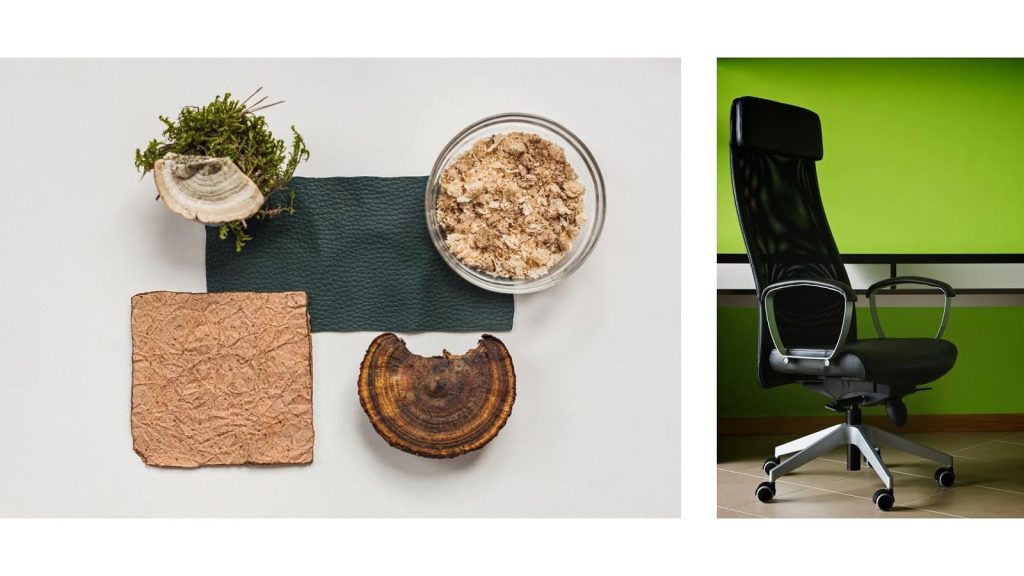
Leather has been around for centuries, used in everything from furniture to clothing. With the increase in awareness about the environment and sustainable living, many people are looking for eco-friendly leather alternatives. You may be wondering if eco leather is a better option than faux leather, but what’s the difference between eco leather and faux leather? And which is better for the environment? Here’s a breakdown of the pros and cons of eco leather vs faux leather. Read on!
What is eco leather and what is faux leather?
Eco leather is made from natural resources such as cork, apple peels and other renewable materials. It is a sustainable alternative to traditional leather that does not use animal products or harsh chemicals in its production process.
Faux leather, on the other hand, is typically made of polyurethane and/or polyvinyl chloride (PVC). While it looks like genuine leather, it’s actually composed of plastic material that closely mimics the look and feel of real leather without utilizing any animal skins or by-products.
Both eco leather and faux leather are considered vegan friendly because they do not contain any animal products or by-products.
Key differences between eco leather and faux leather
- Eco leather is made of recycled materials and fabrics, while faux leather is made from synthetic polymers.
- Eco leather has a more natural look and feel, while faux leather appears shiny or plastic-like.
- Eco leather is more durable than faux leather, with better resistance to wear and tear.
- Eco leather is generally more expensive than faux leather due to its superior quality and environmental credentials.
- Faux leather may contain toxins or chemicals that could be hazardous to your health, whereas eco-leather does not contain any such substances.
- Eco Leather is also easier to clean and maintain compared to Faux Leather due to the absence of harsh chemicals in its manufacturing process.
- Lastly, eco-leather products are often more sustainable and have less of an environmental impact than faux leather. This makes them a great choice for eco-conscious consumers.
In short, eco leather is the better option when it comes to buying quality and environmentally friendly materials. It is more durable, has a natural look, does not contain toxins or chemicals, and is also easier to clean and maintain. Eco-leather is also often more expensive than faux leather due to its superior quality and environmental credentials. However, if you want a material that looks good while remaining environmentally conscious then eco-leather may be worth the extra spend.

Pros of eco leather over faux leather
- Eco leather is more durable than faux leather, making it a better choice for furniture and upholstery.
- Eco leather is breathable, allowing air to circulate through the material more easily than faux leather.
- Eco leather is often made with natural materials like cotton or hemp, making it a more sustainable alternative to synthetic materials in faux leather.
- Eco leather has a unique texture and look that can give items an elegant or rustic feel, depending on the type of fabric used.
- Eco leather is typically less expensive than genuine or faux leather, which makes it a great option for those looking to save money while still enjoying the beauty of high-quality fabrics.
- Eco-leather also lasts longer than conventional man made materials, making it a great choice for long-term investments.
- Eco leather is also biodegradable, meaning that when it reaches the end of its life cycle, it won’t be adding to landfill waste.
- Finally, eco leather is more resistant to water and stains than faux leather, making it easier to clean and maintain.
Overall, eco leather offers a durable, stylish and sustainable alternative to synthetic materials in faux leather. Its unique texture and look make it an ideal choice for upholstery or furniture while its affordability makes it an attractive option for anyone looking to save money without sacrificing quality. Additionally, its sustainability factor makes eco leather a great choice for those who are environmentally conscious.
Cons of eco leather compared to faux leather
- Eco leather is more expensive than faux leather, making it less accessible to those on a budget.
- Eco leather often has a shorter lifespan than faux leather, meaning it will need replacing sooner.
- It is not as durable or flexible as faux leather, so it may be uncomfortable to sit on in certain situations.
- It tends to fade over time, often changing the colour of the material and causing discoloration or cracking with age.
- Some types of eco leather are difficult to clean and may require specialized cleaning materials that can be costly and time-consuming to obtain.
- Synthetic chemicals used in processing eco leather can sometimes emit harmful toxins into the environment and atmosphere when exposed for long periods of time.
- Eco leather may not be as animal-friendly as faux leather, since some types are made from real animal hides.
- Depending on the type of eco leather used, it may not be waterproof or weatherproof like faux leather can be.
- Eco leather often has a more distinctive odor than faux leather, which can be unpleasant for some people.
- It is not as resistant to staining and other forms of damage compared to faux leather, meaning you will need to take extra care when handling it.
Overall, although eco leather does have its pros and cons in comparison to faux leather, it is still a great alternative for those wanting an ethical, environmentally-friendly option for their furniture and clothing needs.
Pros of faux leather over eco leather
- Faux leather is usually less expensive than eco leather since it is made from synthetic materials.
- Faux leather can be readily available and easier to find compared to eco leather.
- Faux leather does not require the same level of care as eco leather, such as regular conditioning or stitching repairs; it needs only minimal upkeep.
- It is also softer and more pliable than eco leather, making it easier to work with for furniture upholstery or clothing garments.
- Faux leather has a consistent texture so it is often preferred in products that need uniformity such as shoes or bags.
- Since faux leather is man-made, it offers greater color variety and design possibilities than eco-leather, which tends to comein more limited color choices.
- Faux leather is much easier to clean, requiring only a damp cloth to remove dirt and debris instead of special leather cleaners or conditioners.
- It is also inherently water resistant and can be used outdoors in some cases.
- Lastly, faux leather emits fewer volatile organic compounds (VOCs) than real leather, making it an environmentally friendly choice.

Cons of faux leather compared to eco leather
- Faux leather is not breathable, making it uncomfortable to wear and difficult to maintain in warm temperatures.
- Faux leather has a shorter lifespan than eco leather and is prone to cracking, fading and tearing more easily than its more durable counterpart.
- It is not as water resistant as eco leather and cannot be subjected to the same harsh cleaning practices that can be used with genuine leather goods.
- Faux leather may contain harmful chemicals like phthalates which can damage your skin if worn for prolonged periods of time.
- Over time, the material can begin to feel stiff or brittle due to exposure to sunlight, heat and moisture, so frequent maintenance will be required in order for faux leather products to remain looking new for long periods of time.
- Faux leather is not biodegradable and has more of an environmental impact than eco leather due to the production process used to create it.
- It also tends to be less durable than eco leather, making it less suitable for items that need frequent use or heavy duty wear and tear.
- Lastly, faux leather does not have the same luxurious feel or look as genuine leather, meaning it may not always fit the intended aesthetic of an outfit or home decor piece.
As you can see, there are several drawbacks to using faux leather instead of eco-friendly alternatives like vegetable-tanned leathers or other sustainable materials such as cork or bamboo.
Situations when eco leather is better than faux leather
- Environmentally Friendly: Eco leather is made from sustainable, renewable sources like vegetable-tanned leather or cork. It does not contain any toxic chemicals used in the production of faux leather and does not contribute to environmental pollution.
- Durability: Eco leather is known for its durability and can last longer than faux leather which tends to flake or peel after some time.3. Comfort: Since it is made of natural materials, eco-leather is breathable and comfortable as compared to synthetic fabrics like vinyl which can be too hot or sticky during summers.
- Cost Saving: Eco-leather may cost more initially but will pay off in the long run because of its longevity and quality construction. It also requires less maintenance than faux leather, hence it is a cost-effective choice.
- Style: Eco-leather can provide more stylish options as compared to faux leather which generally looks cheap and artificial. It can be used to create beautiful furniture pieces, handbags and other fashion accessories that will last for years.
- Versatility: Eco-leather is available in a variety of colors, textures, and finishes to match your style preferences and interior décor. It can also be used on different surfaces like walls or floors without any damage or discoloration. This makes it an ideal choice for people who don’t want to invest in expensive upholstery materials or hardwood flooring.
Situations when faux leather is better than eco leather
- Durability: Faux leather is much more durable and resistant to wear and tear than eco leather.
- Cost: Faux leather is typically cheaper than eco leather, making it a great option for budget-conscious buyers.
- Maintenance: Faux leather requires less maintenance when compared to eco leather, which needs regular cleaning and conditioning to keep it looking its best.
- Versatility: Faux leather can be used in a variety of applications, giving you more options for design and decorating your home or office space.
- Animal Welfare: Faux leather does not require the slaughtering of animals for its production, making it an ethical choice for those who are concerned about animal welfare issues.
- Environmentally Friendly: Unlike some types of leather, faux leather does not require the use of harsh chemicals or tanning processes and is often made from recycled materials. This makes it a more sustainable choice for those concerned about their environmental impact.
- Variety: Faux leather comes in a variety of styles, textures and colors. This gives you more options to choose from when designing and decorating your space.
- Comfort: Faux leather is much softer and more comfortable against the skin than eco leather, making it a great choice for furniture upholstery or other items that come into contact with skin on a regular basis.

Eco Leather vs Faux Leather Summary
Hopefully this article helped clear up some confusion about eco leather and faux leather, and left you feeling more confident in your ability to make an informed decision about which kind of product is right for you. If you have any questions that weren’t answered here, or if you want to share your own experiences with eco leather or faux leather, please leave a comment below – we love hearing from our readers!



